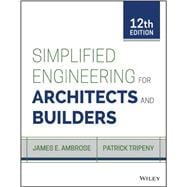Simplified Engineering for Architects and Builders is the go-to reference on structural design, giving architects and designers a concise introduction to the structures commonly used for typical buildings. The clear, accessible presentation is designed to give you the essential engineering information you need without getting bogged down in excess math, making this book an ideal reference for busy design professionals. This new 12th edition has been completely revised to reflect the latest standards and practices. The instructor site includes a complete suite of teaching resources, including an instructor's manual.
Structural design is an essential component of the architect's repertoire, and engineering principles are at the foundation of every sound structure. You need to know the physics, but you don't necessarily need to know all of the math. This book gives you exactly what you need without losing you in a tangle of equations, so you can quickly grasp and apply the material.
- Understand fundamental concepts like forces, loading, and reactions
- Learn how to design for wood, steel, or concrete construction
- Study structural design standards and develop sound structural systems
- Determine the best possible solutions to difficult design challenges
The industry-leading reference for over 80 years, Simplified Engineering for Architects and Builders is the definitive guide to practical structural design.









